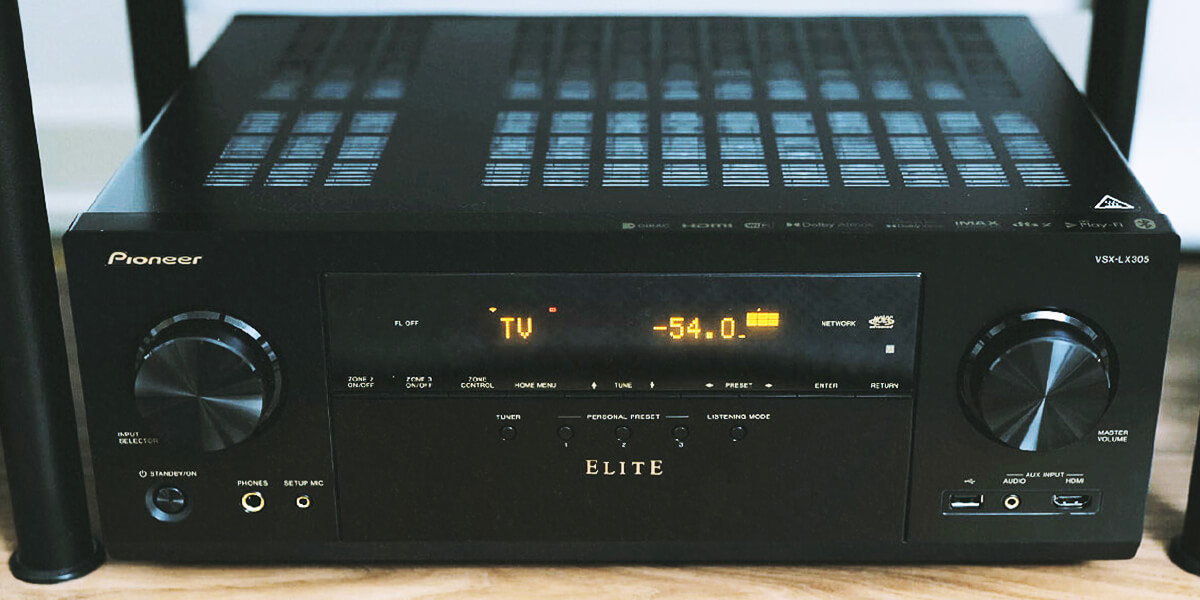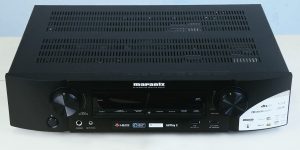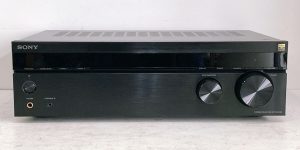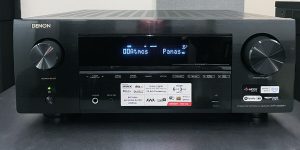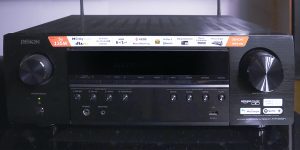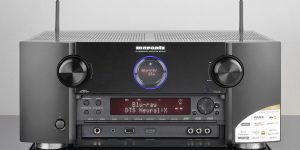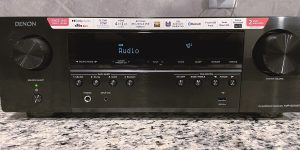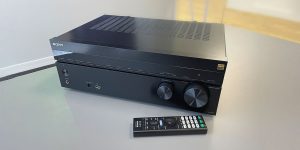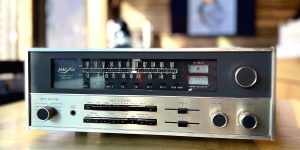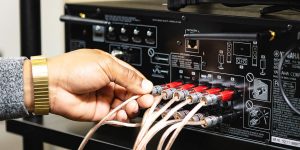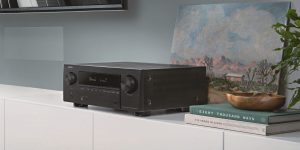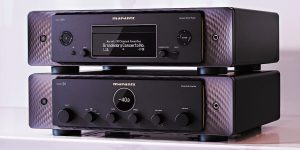Well, I won’t be a pioneer by calling an audio video receiver the center of any home theater. It is quite logical: you connect video or audio sources (Blu-ray, CD player, or game console) to it so that after processing in it, you can get the result on the receiver (projector, TV, but most importantly – speakers). And many people consider assembling such a system an expensive pleasure, which is not so far from the truth. In this review, I have collected several models to prove that you can find the best AV receiver under $1000 and spend the saved money on, say, a good speaker system. But first, let’s understand what you can expect from a receiver of this rank, shall we?
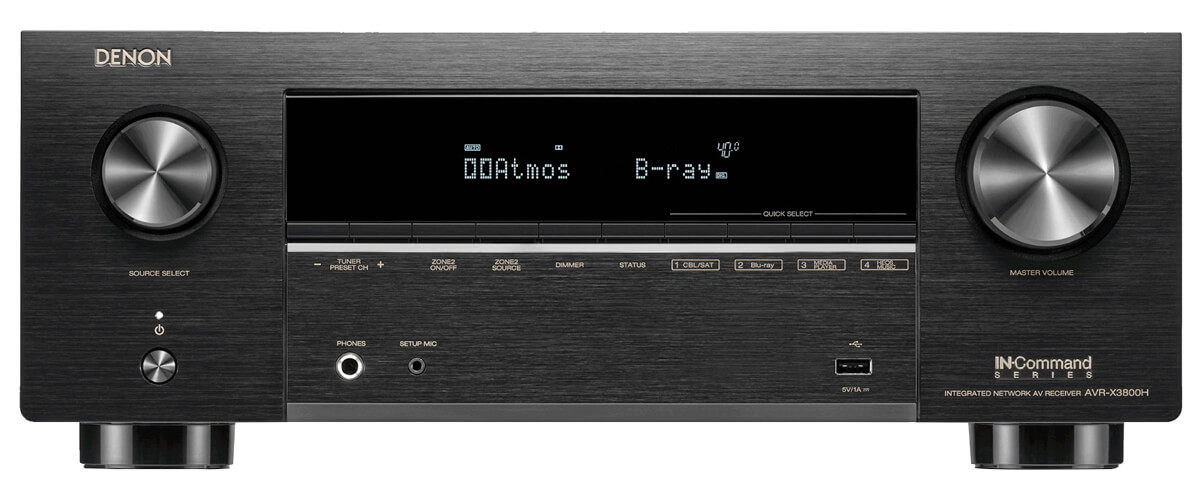
AV receiver under $1000 comparison table
| Name | Channels | Power output | HDMI in/out | Bluetooth/Wi-Fi | Review |
|---|---|---|---|---|---|
| Pioneer Elite VSX-LX305 best overall | 9.2 | 100W/8 Ohm, 225W/6 Ohm | 6/2 | yes/yes | Review |
| Yamaha RX-V6A also a great choice | 7.2 | 100W/8 Ohm | 7/1 | yes/yes | Review |
| Marantz NR1711 compact | 7.1 | 50W/8 Ohm, 70W/6 Ohm | 6/1 | yes/yes | Review |
| Denon AVR-X2800H 2022 model | 7.2 | 95W/8 Ohm, 125W/6 Ohm | 6/2 | yes/yes | Review |
What to expect from a receiver under 1000 dollars?
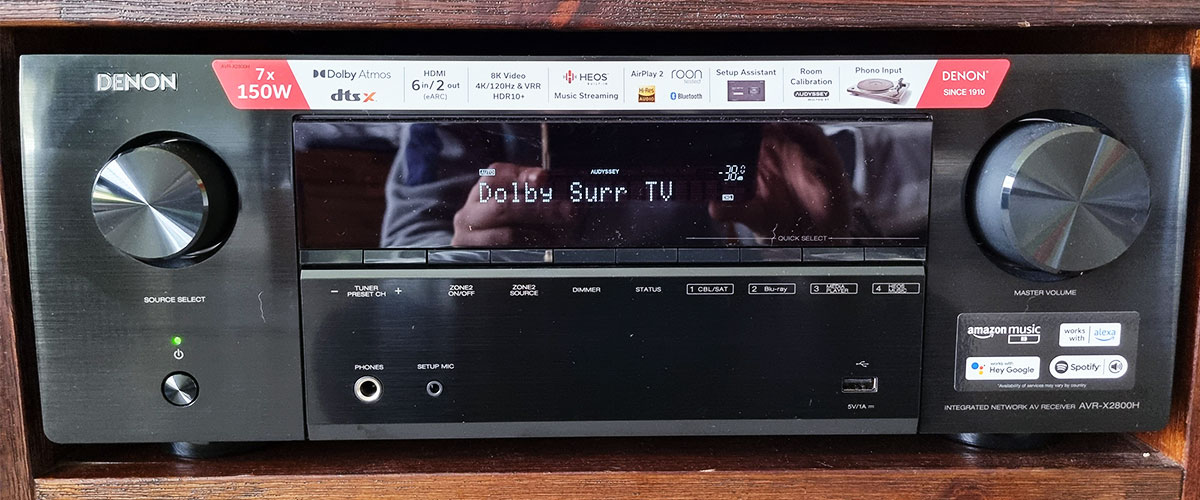
By assembling a home theater system with a receiver of the category in question, you will not be cheated by the manufacturer. They all try to make your leisure time excellent, regardless of how much you pay for their product.
So, to make a long story short, you will get the following “delights”:
Usually, in this category, you can usually find 7-channel receivers (less often 9-channel), which means you can access surround sound formats such as Dolby Atmos and DTS:X. Yes, the configuration to realize three-dimensional sound is minimal, but you get better access to modern content.
In video features, it’s common to see 4K receivers with support for Ultra HD formats& but in my selection, all receivers have 8K processing.
Modern models in the sub-$1000 category have calibration systems and system setup applications, whether you’re experienced or a novice. They’re not as advanced as the more expensive models, but they do the job quite well. Still, I recommend that you do some manual tuning.
Of course, all AVRs of this rank are equipped with wireless technologies (Wi-Fi, Bluetooth, built-in ecosystems), sometimes standard, in later models – advanced. But almost all of their support works with Hi-Res audio, streaming services, and voice assistants.
As you can see, you don’t lose anything regarding functionality. Rather, the compromises concern the internal design (less high-quality components) or less expensive parts (buttons, controls, connectors). Also, the number and variety of connections may be limited relative to more expensive receivers.
Best AV receiver under $1000 reviews
Pioneer Elite VSX-LX305 – best overall
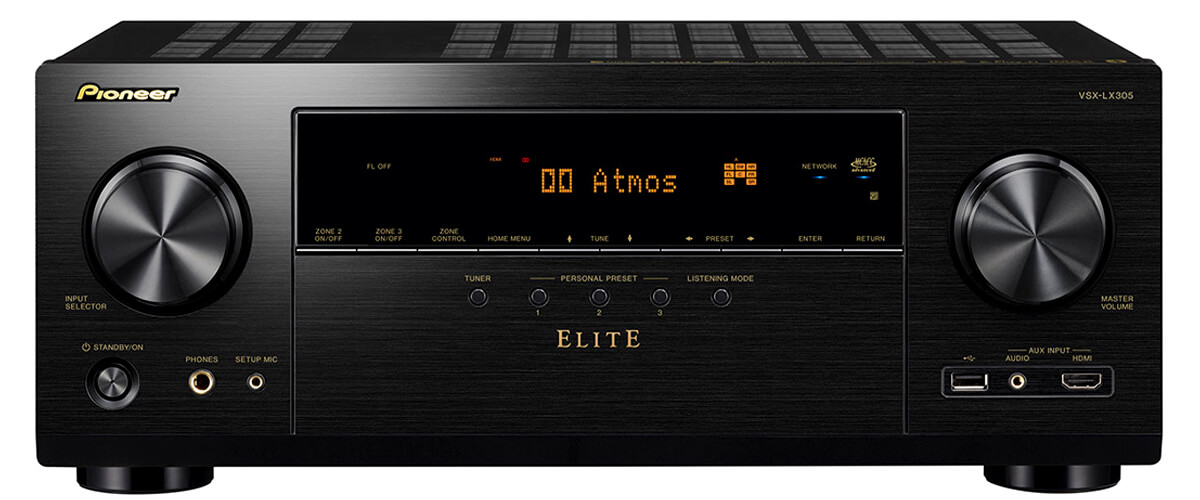
The Pioneer Elite VSX-LX305 review defines the first place in my ranking. Firstly, it is the only 9.2-channel receiver in my rating. And secondly, with this, its main advantage is that the cost of AVR is not much higher than the other competitors. Of course, this price/quality ratio implies some compromises. For example, the device’s design is quite simple and light, which indicates the use of inexpensive internal components. It doesn’t affect the system’s sound (at least, while I have a brand new VSX-LX305 in my hands), but over time, if not handled properly, it can lead to replacing parts faster than other models. But don’t be immediately scared and discard this option. I’m sure many of you carefully handle the equipment, and the system assembly implies a one-time action, after which the home theater is usually not touched at all. There is always a way out!
Externally, the receiver is quite ordinary, but the LCD screen is viewed well. This is a rarity now. I don’t know why, but if the manufacturers decided to compete with each other, who would create the least readable one? Plus, you can quickly access the HDMI port on the front panel. All in all, it’s old-school (yes, I’m a retrograde).
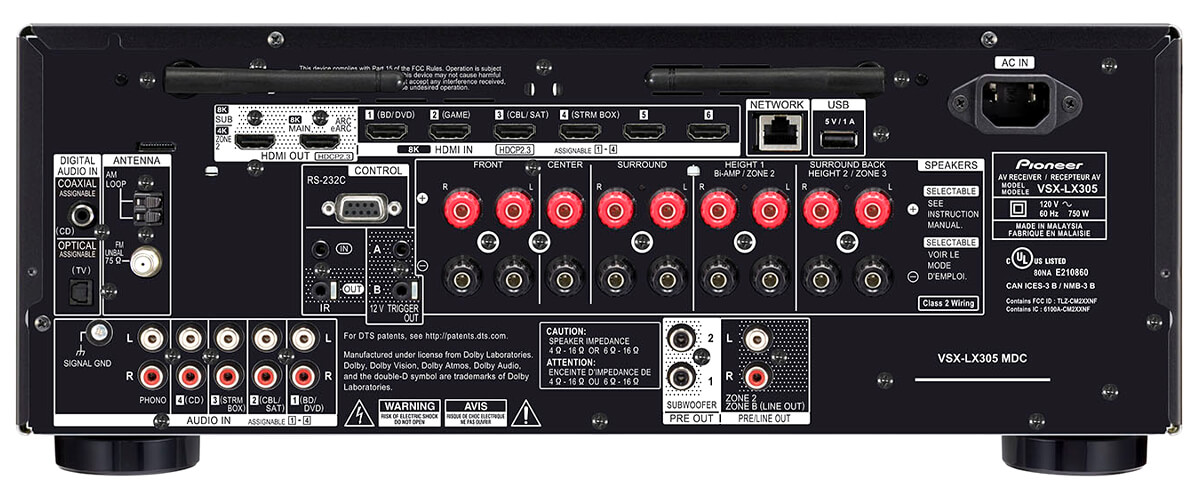
But let’s get to the features, finally. So, the model released in 2021 has 7/2 HDMI ports version 2.1. You can watch 8K videos, enhance the worst resolution to 8K, play consoles, control the whole system with a single remote, and so on. But most importantly, this multi-zone receiver can stream 4K video to a second zone! Convenient if you have kids (trust me).
When it comes to wireless connectivity, the VSX-LX305 is also an advanced modern device, as you can use DTS Play-Fi and AirPlay 2 to broadcast audio throughout your home (streaming services and voice assistants are amply supported) or Bluetooth with support for SBC and AAC codecs. You can also use the Sonos system if you have a dedicated port.
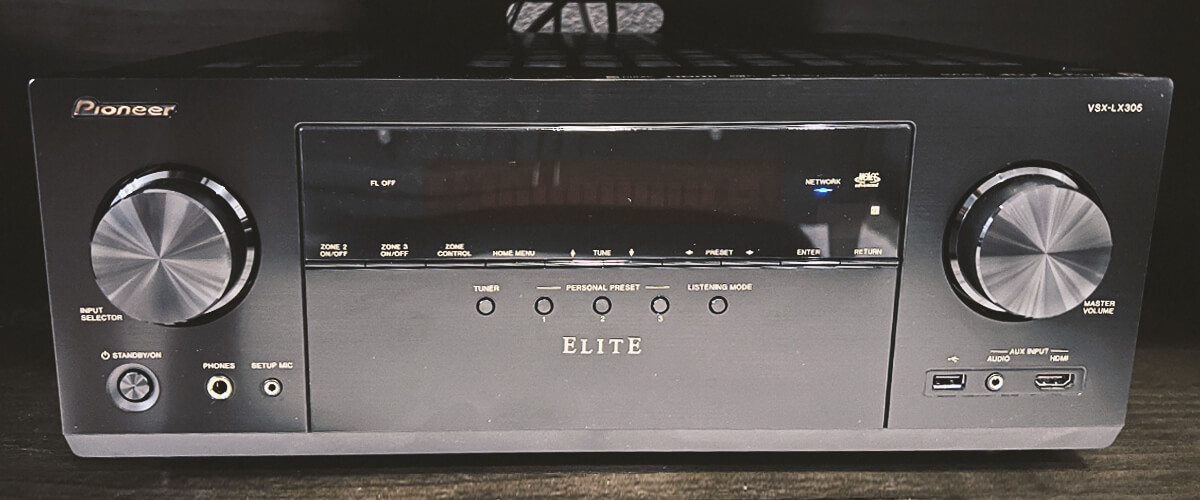
At 100 watts (8 ohms, 20Hz-20kHz, THD 0.08%, 2ch), movies with soundtracks encoded in Dolby Atmos, DTS:X and IMAX Enhanced sound very good. Perhaps not as detailed as in more expensive models with 9 channels of amplification, but if we are considering the medium but budget class category, be indulgent. And I assure you, most of you simply won’t notice a significant difference; you don’t test receivers daily! The sound is excellent: rich, dense, diverse, and with no perceptible interference at high volume.
Pioneer has equipped its receiver with the Dirac Live Room Correction calibration system for a more precise setup. But if you don’t want to spend hours figuring it out (it takes so much effort), try the standard MCACC. It won’t give you perfect settings, but it will save you a lot of stress.
Pioneer has no unique technologies in its range, but it is skillful with the available ones. Making compromises in the design assembly itself, the manufacturer has equipped its receiver with the most significant advanced versions and formats in each important area. Elite VSX-LX305 becomes the first of the best receivers under 1000 of my rating for quite obviously deserved reasons.
Key specs
- Channels: 9.2.
- Power output: 100W/8 Ohm, 225W/6 Ohm.
- HDMI inputs/outputs: 6/2.
- Video functions: 8K/60Hz, 4K/60Hz, 4K/120Hz, upscaling to 8K.
- Bluetooth/Wi-Fi: yes/yes.
- Streaming services: AirPlay 2, Spotify, TuneIn, Deezer, Tidal, Netflix, Amazon Prime.
- Supports: HDMI ARC, HDMI eARC, HDMI CEC, HDCP2.3, HDR10+, Dolby Vision.
- Surround sound: DTS:X, DTS Virtual:X, DTS HD Master, Dolby Atmos, Dolby TrueHD, Dolby Digital Plus, Dolby Atmos Height Virtualizer, IMAX Enhanced, Dirac Live.
Pros
- It is the only 9-channel receiver in this rating.
- Well-viewed and informative LCD.
- The receiver broadcasts a 4K video for Zone 2.
- Bluetooth supports SBC and AAC codecs.
- Wireless streaming is enhanced with built-in DTS Play-Fi and AirPlay 2.
Cons
- It is not the most rugged construction; inexpensive components are used.
- MCACC autocalibration is too easy, and Dirac Live is too complicated.
Yamaha RX-V6A – also a great choice
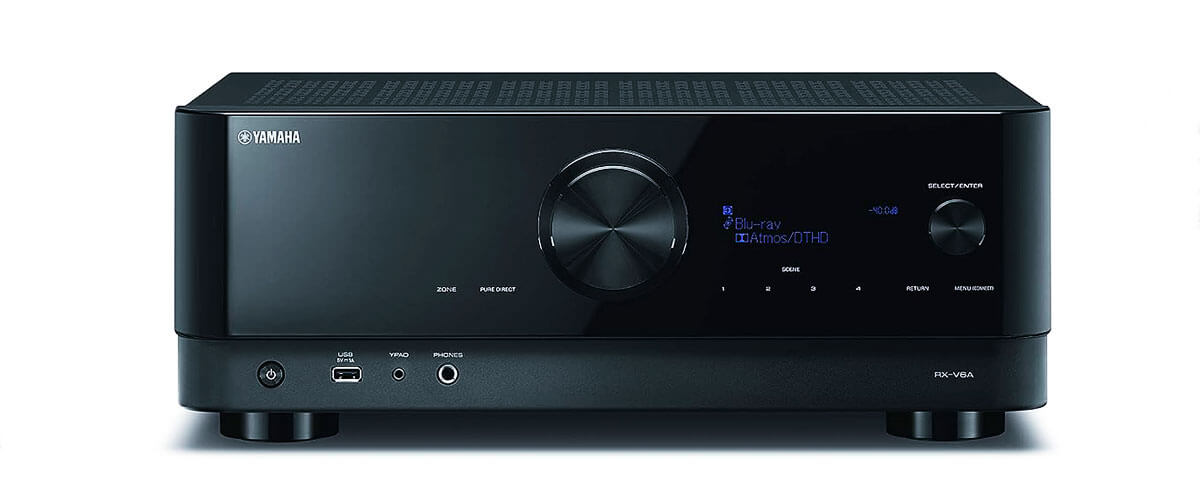
The Yamaha RX-V6A is also an excellent choice. This 7-channel receiver 2020 has identical power of 100 W (8 Ohm, 20 Hz – 20 kHz, 2 ch) to the winner of the rating Pioneer Elite VSX-LX305, but THD 0.06% distortion is a bit better. This means it may sound richer and louder for a smaller room where a system of this rank should be placed. Regarding features, it is also practically as good as the leader, making it my optimal priority in the price/quality category.
The HDMI ports version 2.1 (7/1) allow you to enjoy 8K video but only scale the lower resolution to 4K, where the receiver loses out to the VSX-LX305. It’s not a big deal when you consider that receivers of this rank can’t achieve a perfect match to the actual pixel count, but still.
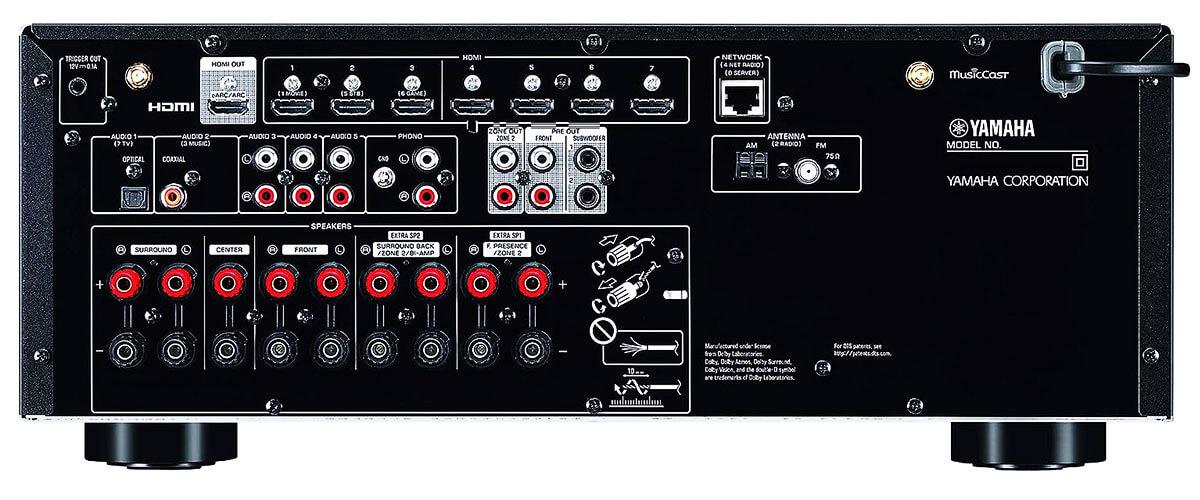
The receiver has 7/1 HDMI version 2.1 ports designed to view 8K resolution video. There’s even upscaling to 4K, greatly improving the picture from my old disks. I also liked how smoothly the CEC option works for such an inexpensive device; I didn’t notice any glitches.
RX-V6A uses standard versions of Wi-Fi and Bluetooth, but it has built-in AirPlay2 and MusicCast multi-room, greatly improving the quality of audio broadcasting throughout the house. As for working with Alexa, I wasn’t impressed. Quite possibly because I’m a fan of other voice assistants, yet I can rate the performance as good/bad. NOT good.
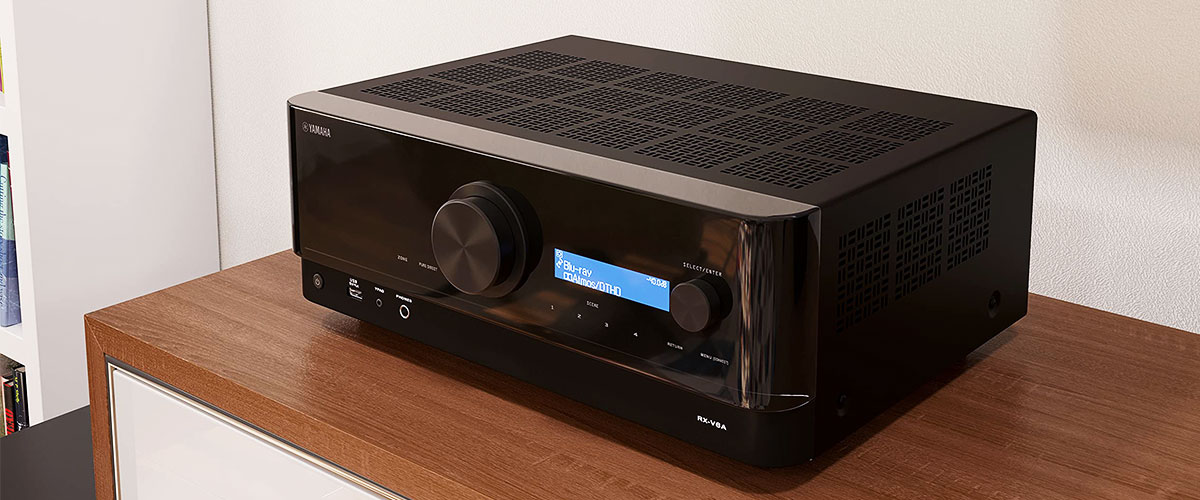
Making a Yamaha RX-V6A review is most important to tell about surround sound. The receiver supports Dolby Atmos and DTS:X, but its main advantages are unique technologies (which are deprived of Pioneer Elite VSX-LX305). For example, if you’re not a fan of embedding Atmos speakers in the ceiling, you’ll appreciate the Virtual Cinema DSP feature, which successfully simulates the sound of the upper channels. Dialogs will become clearer and commercials quieter if you activate Adaptive DRC (Dynamic Range Control). In general, AVR sounds great (for its category), high-quality, and detailed, but for me, it is too crystalline, without proper warmth and coziness.
Yamaha RX-V6A – best home theater receiver under 1000 dollars in the price/quality ratio because it offers rich functionality (as for a 7-channel system) along with an acceptable price. If you like the brand’s chiseled clarity and crystalline sound, this model will be a worthy companion for your home for many years to come.
Key specs
- Channels: 7.2.
- Power output: 100W/8 Ohm.
- HDMI inputs/outputs: 7/1.
- Video functions: 8K/60Hz, 4K/60Hz, 4K/120Hz, 24GBPS HDMI1-3.
- Bluetooth/Wi-Fi: yes/yes.
- Streaming services: Pandora®, Spotify, Amazon Music, SiriusXM, TIDAL, Deezer, Napster.
- Supports: HDMI eARC, HDMI Audio Return Channel, HDMI Pass-through, HDMI Upscaling, HDR 10+, VRR & ALLM, Dolby Vision.
- Surround sound: DTS:X, DTS-HD Master Audio, Dolby Surround, Dolby Digital Plus, Dolby TrueHD, Dolby Atmos, Dolby Atmos Height Virtualization, SILENT Cinema / Virtual Cinema DSP, Dialogue Lift, Virtual Surround Back Speaker, Virtual Presence Speaker, Dialog Level Adjustment, Cinema DSP.
Pros
- Optimal price/quality ratio.
- The Virtual Cinema DSP function mimics the Atmos effect well.
- The Adaptive DRC function adjusts the volume level of dialogs and advertisements.
Cons
- Upscaling to 4K only.
- Alexa doesn’t work very well.
- Neutral cold sound may not appeal to everyone.
Marantz NR1711 – compact
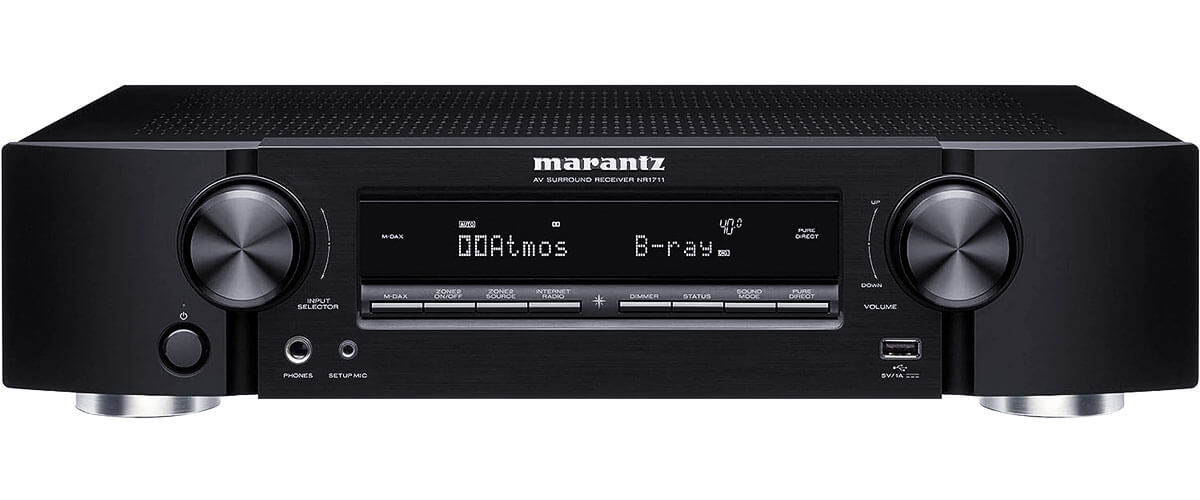
In my mini Marantz NR1711 review, I will tell you about a thin-profile 7-channel receiver, which, thanks to some compromises on the manufacturer’s part, got into the same price range as other chart participants. Generally, brand equipment under identical conditions is always more expensive because it uses elite components. Let’s take a closer look at what concessions Marantz made in this case.
So, we have a compact case 17.3 x 14.8 x 4.1 inches with a weight of 18.2 pounds. That tells us that they’ve crammed the components of a full-size receiver into it, simplifying it and packing it to the brim. The distortion index tells us that the sound is intact (usually, with such an arrangement of internals, electrical interference is more common), but the power can not be “full”, and we end up with 50 watts (8 ohms, 20 Hz – 20 kHz, 0.08% 2ch Drive). In principle, it is still within acceptable limits for small systems, but 2 times less than the VSX-LX305 and Yamaha RX-V6A. So much for compromise! But you will have DTS:X and Dolby Atmos.
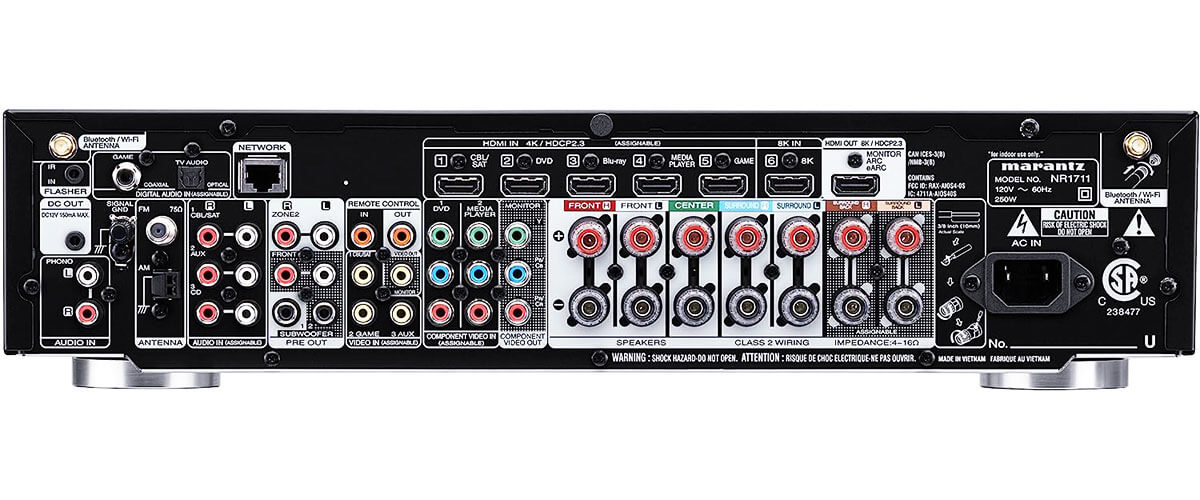
The Marantz NR1711 has fewer connectors than the other models in this selection. And only 1 of the 6 HDMI inputs supports 8K video (the others work with 4K). And in the wireless connectivity area, there’s AirPlay2 and HEOS ecosystem (in addition to Wi-Fi and Bluetooth). It works well with streaming services and voice assistants Siri and Amazon Alexa.
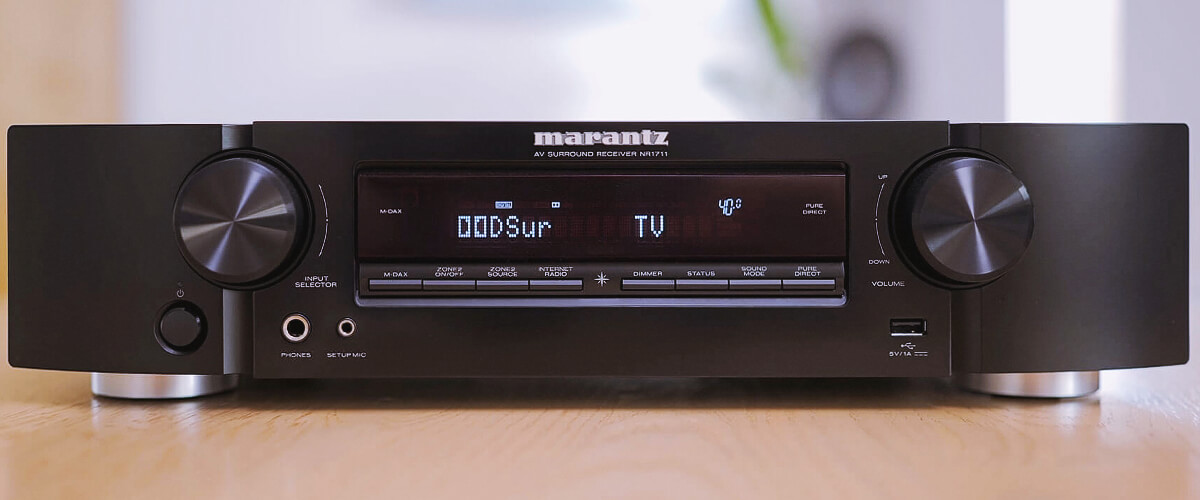
The receiver also has a rather simpler Audyssey calibration system than its more expensive brethren in the Marantz lineup. However, it’s still better than, for example, MCACC on the Pioneer Elite VSX-LX305. It is more adaptive and can satisfy the not-too-sophisticated viewer with its automatic settings. But MDAX2 technology will please music lovers, as it improves low-quality audio formats almost to the Hi-Res level.
Marantz NR1711 is a unique surround sound receiver of my selection because it combines small size without compromising on sound quality. Whether it’s movie surround sound or stereo, it’s hard to find a higher-end receiver at a reasonable price for a small room.
Key specs
- Channels: 7.1.
- Power output: 50W/8 Ohm, 70W/6 Ohm.
- HDMI inputs/outputs: 6/1.
- Video functions: 8K/60Hz, 4K/120Hz.
- Bluetooth/Wi-Fi: yes/yes.
- Streaming services: AirPlay 2, Spotify, TuneIn, Deezer, Tidal, Netflix, Amazon Prime.
- Supports: HDMI ARC, HDMI eARC, HDCP2.3 support, HDCP2.3, Dolby Vision, HDR 10+, Dynamic HDR, ALLM, QMS, QFT, VRR, HLG, Dolby Vision.
- Surround sound: DTS HD Master, DTS:X, DTS Neural:X, DTS Virtual:X, Dolby TrueHD, Dolby Atmos, Dolby Surround, Dolby Height Virtualization, Audyssey.
Pros
- Compact size and weight are suitable for small rooms.
- Very low THD for this size.
- Works great with streaming services and voice assistants.
- The Audyssey sound calibration system is more adaptive than MCACC on the Pioneer Elite VSX-LX305.
- MDAX2 technology improves the quality of compressed files.
Cons
- Smallest power output at 50W of the entire rating.
- Fewer connectors than other models in the rating.
- Only 1 HDMI port works with 8K resolution.
Denon AVR-X2800H – 2022 model
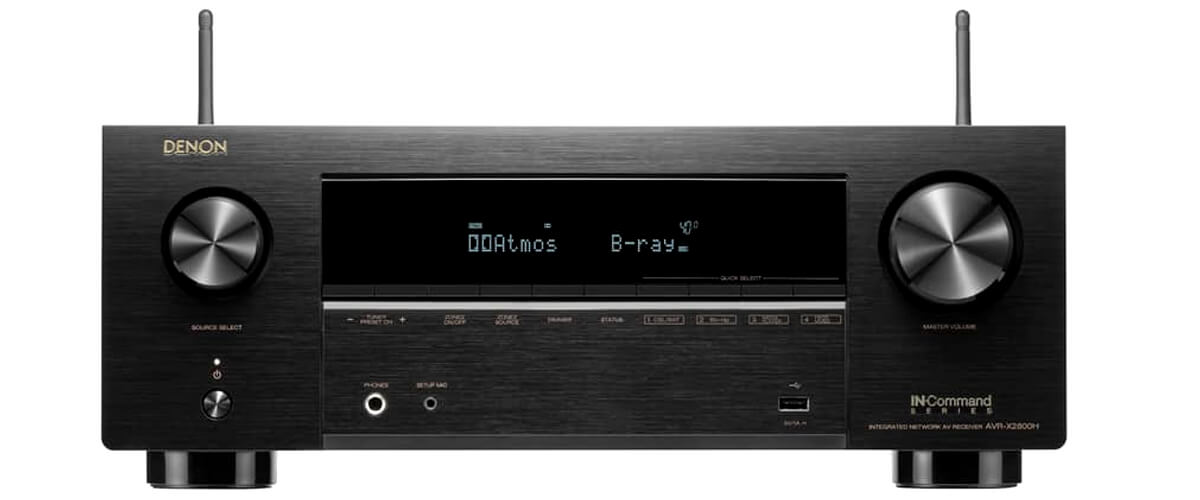
This is the last in my Denon AVR-X2800H review list about a receiver that is no better, no worse, but definitely newer than all of the above. The model was released in 2022, and by and large, it follows the functionality of its predecessors to a greater or lesser extent, so I’ll start with the fact that we are again dealing with 7 channels of amplification and 95W of power (8 ohms, 20Hz – 20kHz, 0.08%, 2ch).
We have the same number of HDMI ports as the Marantz NR1711 (6/2. All right, one more, but pity the little NR1711; there was no place to shove an extra output into it). There are 3 HDMI 2.1 inputs with 8K support and upscaling. As you can see, give or take, everything is identical.
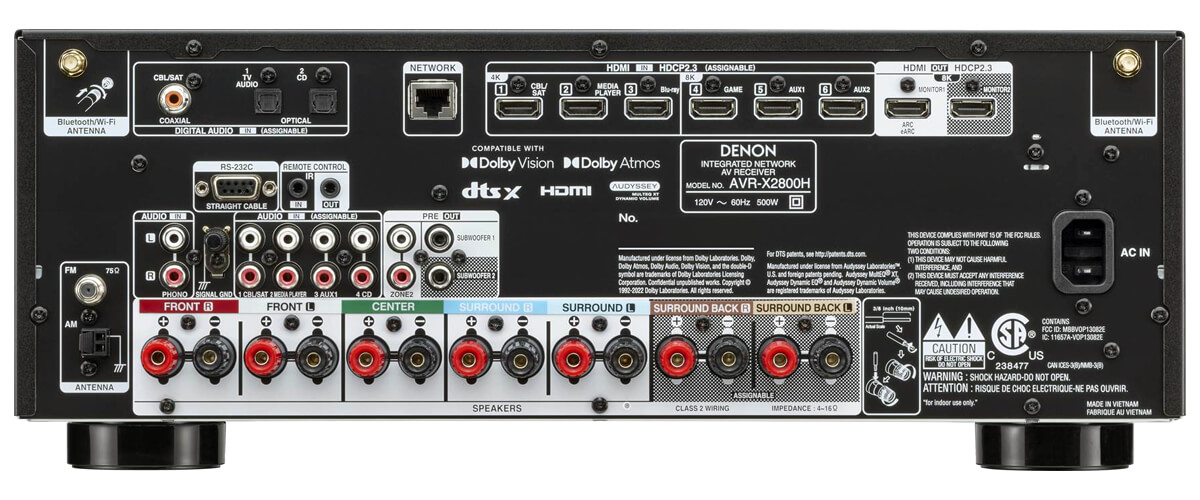
I won’t even repeat about the wireless connection because everything is like a copycat from Marantz. Nothing surprising since some time ago, the brands united into a single concern and used identical technologies and features for their AVRs.
Well, Dolby Atmos and DTS:X surround sound is provided, although there are versions here that allow you to leave your speakers on the floor/shelves and not use ceiling speakers for “more immersive 3D sound”. I generally like DTS Virtual:X and Dolby Atmos Height Virtualization for minimal systems because I can barely hear the difference (2 ceiling speakers don’t allow you to experience the delights of the “voice of god” fully). But the Denon AVR-X2800H has one bug: the Audyssey room correction system sees 2 subs as a single unit, so I would immediately count on a 7.1 system if I were you. This is a minor drawback, as two subwoofers are unnecessary in a 300-400 square feet room.
Of the bonuses, I would point out the bi-amping feature and the high-quality 384kHz/32-bit DAC. I can hear the difference and appreciate the high signal processing results in music and movies. In general, I really like Denon dynamics, which, even in inexpensive models, stand out when watching movies with rich soundtracks.
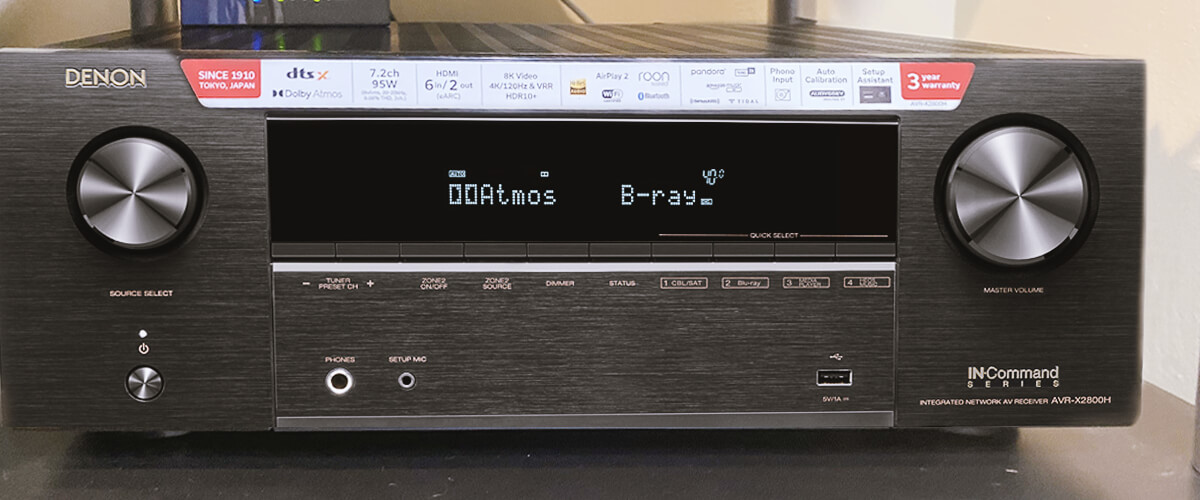
If you have a deaf or hard-of-hearing person in your family, they can use headphones while the rest of the family listens to sound through the speakers. It’s a unique listening experience, and I think it’s a good idea.
Denon AVR-X2800H – best AVR under 1000$ on my list if you appreciate warm, cozy sound without compromises. A worthy representative of its category, it combines affordable price, high-quality audio signal transmission, high-quality picture, and pleasant bonuses for your leisure time.
Key specs
- Channels: 7.2.
- Power output: 95W/8 Ohm, 125W/6 Ohm.
- HDMI inputs/outputs: 6/2.
- Video functions: 8K/60Hz, 4K/60Hz, 4K/120Hz, upscaling to 8K.
- Bluetooth/Wi-Fi: yes/yes.
- Streaming services: AirPlay 2, Spotify, TuneIn, Deezer, Tidal, Netflix, Amazon Prime.
- Supports: HDMI ARC, HDMI eARC, HDMI CEC, HDCP2.3, HDR10+, HLG, Dolby Vision.
- Surround sound: DTS:X, DTS Neural:X, DTS Virtual:X, Dolby Atmos, Dolby Atmos Height Virtualization, DTS HD Master, Dolby TrueHD, Multichannel Stereo.
Pros
- Support for immersive virtual formats eliminates the need to build speakers into the ceiling. At the same time, the sound quality practically does not suffer.
- A high-quality 384kHz/32-bit DAC is used.
- Audio can be listened to simultaneously from the speakers and headphones.
Cons
- Denon AVR-X2800H is a 7.1 receiver because the calibration system treats 2 subwoofers as 1.

